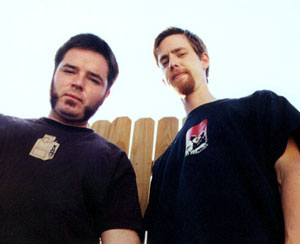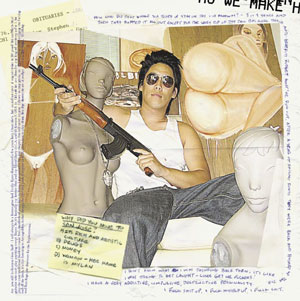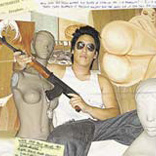Last month, hundreds of readers assaulted Mark Searcy and Brian Gibb, the founders / publishers / designers of a stellar new zine called Art Prostitute, at their Issue 04 release party that took place at the Little Temple in Los Angeles.
Last month, hundreds of readers assaulted Mark Searcy and Brian Gibb, the founders / publishers / designers of a stellar new zine called Art Prostitute, at their Issue 04 release party that took place at the Little Temple in Los Angeles. As the designers-turned-renaissance men exited their shiny new Scion (donated by Toyota for the event), they were lucky to make it inside the venue with their clothes intact.
“Whores. Whores. Whores.” the mob chanted.
“When I graduated from the University of North Texas, I didn’t want to work in an advertising agency or a graphic design environment,” Searcy said. “I just wanted to travel and get into art.” In other words, he wanted to be an art prostitute.
That was in May of 2002, and Searcy and design school classmate Gibb spent the summer developing a formula to be just that, and to preach the moneymaker free-for-all art ethos via a slick, well-designed quarterly magazine and website. The guiding principle behind Art Prostitute is that art is democratic and available to everyone, regardless of geography or economics.
“Other publications showcase the art, but they do not give artists a voice. We have a format where we give you a good feeling for the artists,” Searcy said. “The magazine conduces to their art, as opposed to putting their art into a template, but really what we want people to get out of the magazine is how these artists make a living.”
Searcy and Gibb are trying to correct the misnomer that art is (or should be) inaccessible. They include projects in the magazine, encouraging readers to participate in these projects. Perhaps more importantly, they include limited-run posters in the magazine of the artists’ work that they feature, in the hope that readers will actually hang this art on the walls of their homes and offices.
“Most art publications present the artist as untouchable, and even the magazine itself is presented as an untouchable,” Searcy said. “Their readers don’t feel like they could be in an art magazine. We really want to hit on the theme that you can own your own creativity, if you are a creative person. We give people that outlet where they can be that and get some exposure by just participating in a project.”
Gibb also has an explanation of what the magazine is doing for its growing legion of readers and fans: “We want to give people an opportunity [to own art], by putting prints in the magazine; but we want to educate people as well. Not only on how to promote themselves, but how they can support original art.”
Searcy and Gibb certainly aren’t the first to preach the doctrine of cheap art, but they are amongst the vanguard of those who are marrying art with the values of dirt-cheap, mass-marketed, good design that dominated consumer retailing in the 1990s. For the same amount of money someone will spend on a framed Van Gogh poster, the Art Prostitutes argue that person can have an original print by a living artist, one that grows in value: “[Old master posters] are worth only $10 in materials, and have no value that can appreciate over time. If a Shepard Fairey print sells out, that is it. There is no more. Instantly, your print jumps in value, and that is what we want to educate people on.”
How realistic this argument may be given the usual time value of money with regard to art collecting (and the fact that cheapness can only succeed with volume), Art Prostitute is making an important contribution as a clever promoter of such emerging artists as Shepard Fairey, Angela Boatwright, Evan Hecox, Dave Kinsey, Matt Owens, Gary Baseman and many others. And the founders of the magazine will tell you frankly that meeting and hanging out with artists is one of the reasons they do the magazine.
“The experience that we had with artists, Shepard Fairey for instance,” Gibb says. “That guy is so big, so blown up and he is just the nicest guy that we have ever met. He was just so generous with everything. We visited his studio, we brought him gifts and he gave us armloads and armloads of stuff to take back, give to our friends, and put on the streets or what ever we wanted to do with it. Plus, the fact that if there is anything that the artists (that Art Prostitute has worked with) can do to support the cause, they will, because we do it for them and that is what we have set out to do. Art Prostitute is just a vehicle for all these artists. We want them to realize that after the interviews have stopped and the issue is put to bed, it isn’t over. It is not ‘Thanks for being in our magazine. We are going to sell 1,000 copies. Later.’ That is not what we are into. We want a strong community and that is where Art Prostitute is going in general. Not just a magazine, not just a website, but people say, ‘man those Art Prostitute guys, they really care about art.'”
“When we visit other cities for the release parties, it is like we are a rock band coming into town,” Searcy said laughing. “We never have to worry about a place to stay.”
Besides the inclusion of prints, the best quality about Art Prostitute is the design. Searcy and Gibb know their chops, and the magazine is a walking advertisement for the design department at UNT. They have even recently been featured in Print and Mass Appeal magazines.
“I’m not afraid to take risks with Art Prostitute because we are totally balls out,” Gibb said seriously. “On the whole, most people don’t notice good design until they see it and they go ‘Wow.’ We are not cranking out a piece of shit, and so everybody is down to be a part of [our magazine]. I admit Art Prostitute does stand out amongst those other sad looking magazines.”
True. True.





